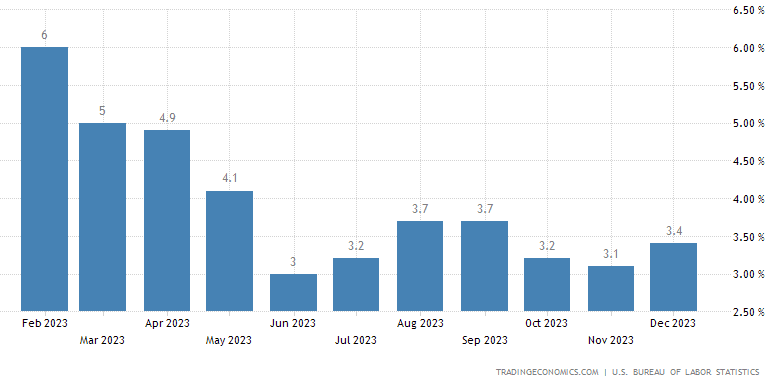U.S. Dollar: Inflation Predicted To Read at 2.5% By Truflation
- Written by: Gary Howes
-

Image © Adobe Images
U.S. CPI inflation for January is predicted to read at 2.5% year-on-year when released on Tuesday, according to Truflation, in an outcome that would represent a significant undershoot to the 2.9% the market is looking for and result in a weaker Dollar.
"We expect the Bureau of Labor Statistics (BLS) to report a significant decline in inflation for January, down from December’s 3.4% to 2.5%, driven by the well-documented phenomenon of January blues," says Oliver Rust, head of product at Truflation.
The Dollar has trended higher through 2024 as market participants fade expectations for the timing of the first U.S. Federal Reserve rate cut owing to robust economic data.
But an undershoot in the inflation reading, as predicted by Truflation, would potentially see some of the recent USD strength unwind as markets boost rate cut bets once more.
Truflation estimates the U.S. inflation rate via the daily indexing of goods and services from numerous data points. The company says this ensures its data outperform monthly measures.
The drop in inflation would put it within touching distance of the Federal Reserve's 2.0% target, but the company warns its prediction for January is based on last year's category weightings from the BLS.
Truflation also cautions that inflation will pick up again over the coming months with the U.S. economy continuing to show strength, "so there is very little reason for the Federal Reserve to start cutting rates before the summer".
This would also ensure any U.S. Dollar weakness following Tuesday's release proves relatively short-lived.
Above: U.S. inflation outturns. Image: Trading Economics.
Truflation's data shows that in January, consumers tempered their spending on luxury items typically bought during the festive season.
The main categories in Truflation’s real-time U.S. CPI index that contributed to the downward trend were food, alcohol, apparel and household durables – down 0.58%, 0.47%, 1.29%, and 0.62% month-over-month, respectively.
Transportation also saw a 0.48% decrease, marking the fourth monthly decline in a row and bringing down the annualised inflation rate to 1.78% y/y.
"This was, again, driven by a decline in gasoline prices, as well as the drop in passenger numbers as holiday travel came to a standstill. However, with the escalating conflict in the Red Sea and storms slamming US production, we would not be surprised to see a rebound in prices in this category in the coming months," says Rust.
Regarding upside pressures, Truflation sees owned housing, utilities, and healthcare playing roles.
"House prices are being supported by ongoing supply shortages, while inflation in the latter two sectors is, to a large extent, driven by the lingering tightness in the labour market," says Rust.
The U.S. labour market shows ongoing robust job growth and wage pressures, which in turn underpins inflation and is a key reason why the Fed has indicated it won't rush into a rate cut.
"The consumption boom is continuing, and the economy reflects this. GDP growth in Q4 exceeded expectations at 3.3%, while investment markets are also booming. There is very little indication that inflation will continue falling for the rest of Q1, nor is there any justification for a rate cut any time soon. Those expecting an imminent victory in the battle against inflation will be disappointed," says Rust.












